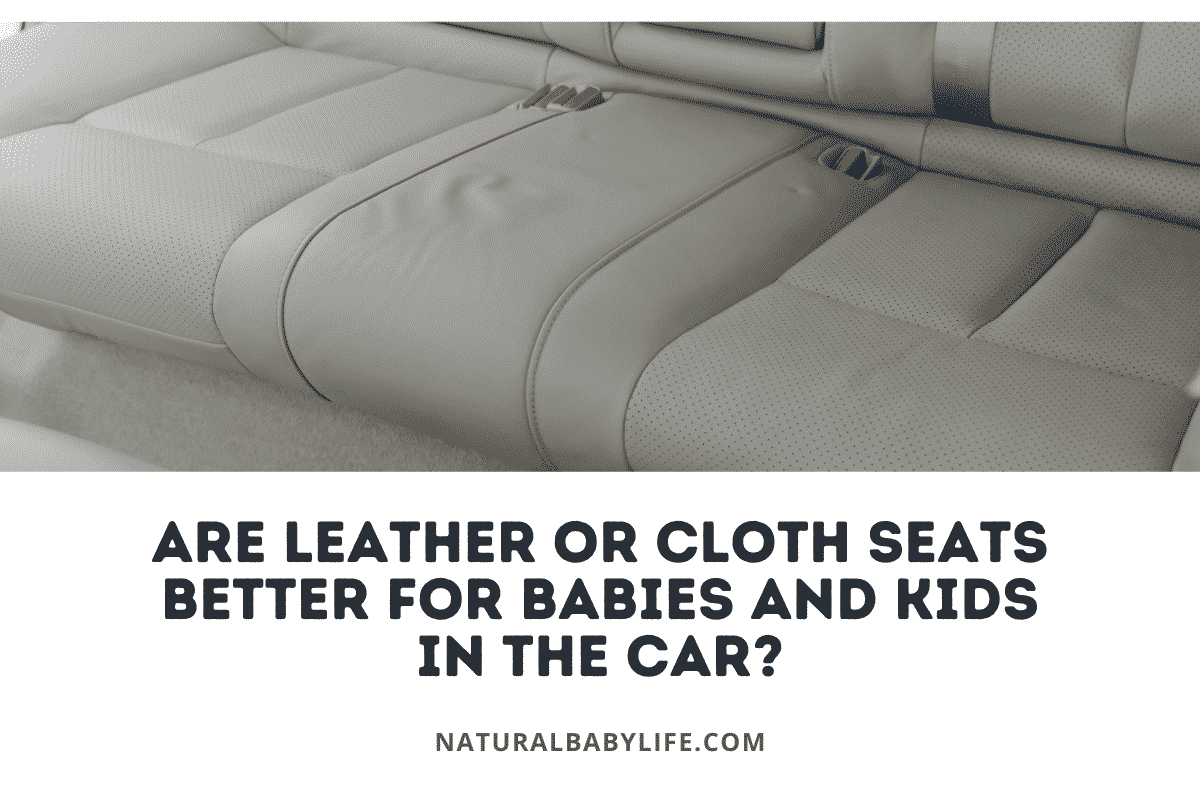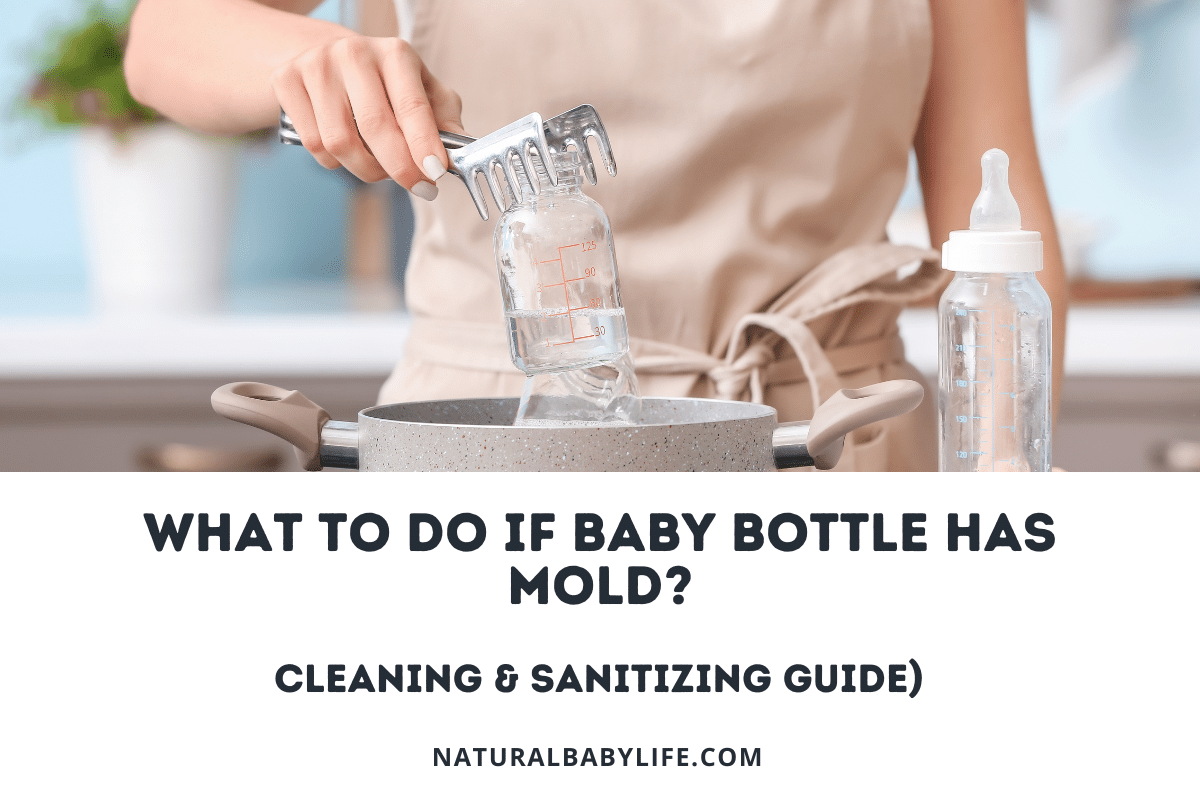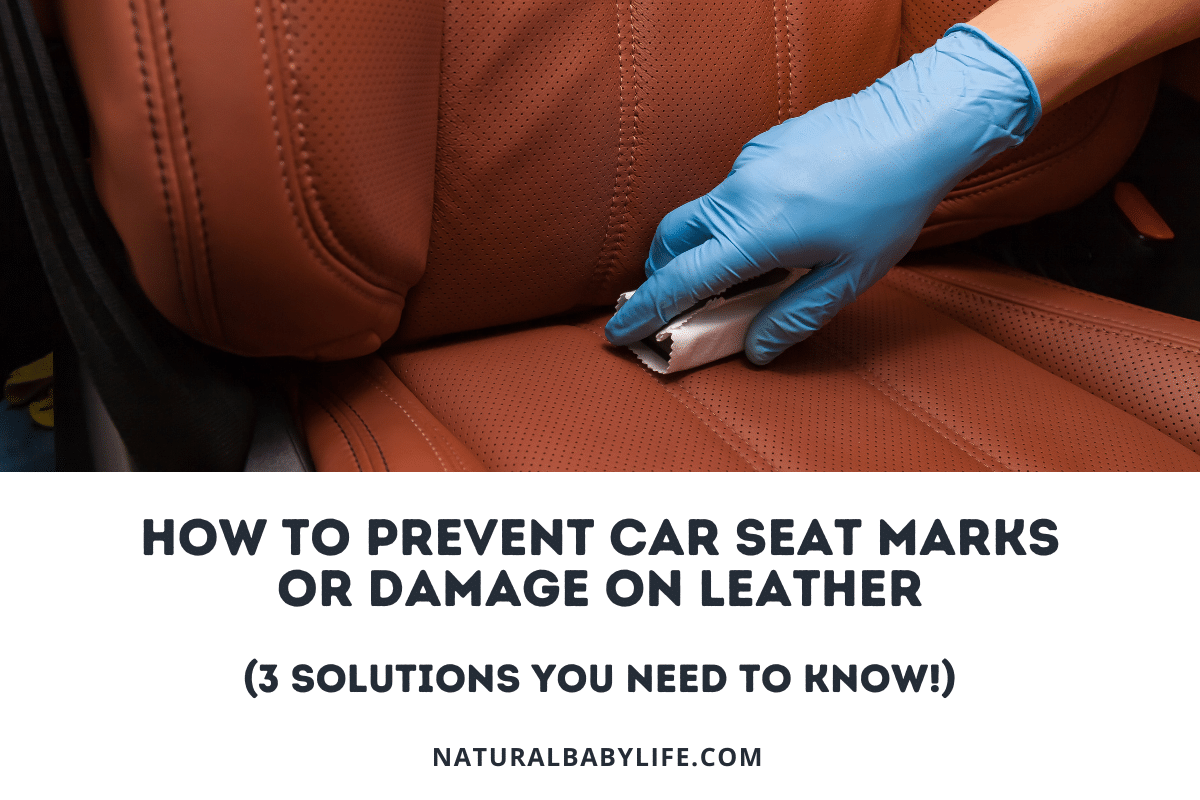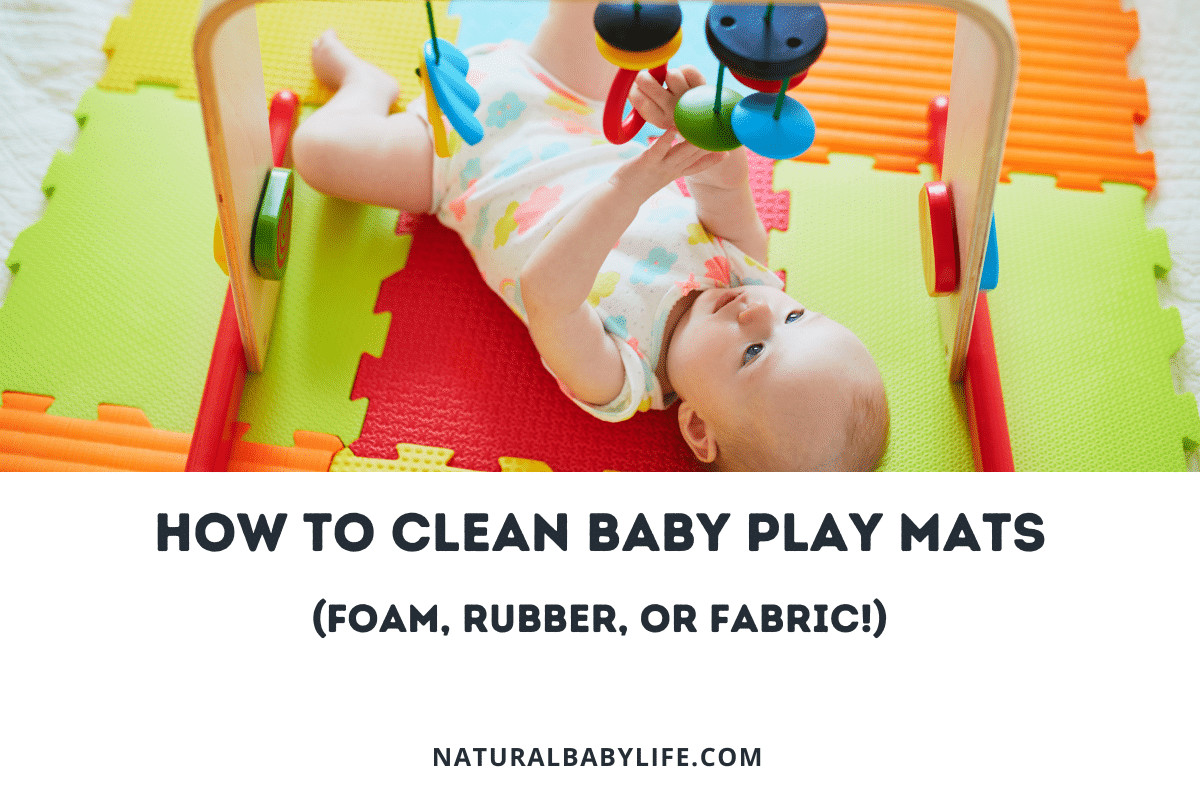If you’ve just had your first child or are planning to purchase a new car, you may wonder whether leather or cloth seats are better for babies and kids. Depending on your budget, lifestyle, and willingness to regularly clean them, either can be a great choice.
If you can afford it, leather can be the most durable and stain-resistant choice for the seats in your car. Leather is easier to keep clean regularly and is more durable over time with proper care. Although the material is slippery and hot in the summer, there are things you can do to compensate for those shortcomings.
Read on to find out if leather or cloth seats are better for babies and kids in the car. You’ll discover in-depth information on the different types of materials, the pros and cons of each, and detailed steps on how to clean them. Use this information to decide what’s best for your family.
Table of Contents
Is it better to have cloth or leather car seats with babies and kids?
There are a variety of factors that determine which upholstery material is best for your car with babies and kids. It also comes down to a matter of personal preference in many cases.
Leather or faux leather seats are a great option for folks with babies and kids if it’s within your budget. They are easier to keep clean, have a sleek look, and can be very durable when taken care of. There are also options for overcoming their cons like heated seats in the winter or even laying a towel over a hot seat in the summer.
But, before you make up your mind, let’s take a look at each option so you can make the choice that’s right for you.
Are leather seats easier to clean than cloth?
There are a few types of leather that are used for car upholstery depending on the price of the car. It’s important to know the type of leather your car has so you don’t damage it during the cleaning process.
Leather seats are easier to keep clean than cloth seats. In most cases, dirt and spills can be wiped off with a damp cloth before they become a problem. Leather also doesn’t absorb spills, and odors as easily as cloth seats.
Some types of leather are easier to clean than others, so let’s take a look at the differences.
Real Leather
Leather seats are becoming more accessible. They are included in mid-range and premium car trims from many manufacturers and are luxurious if you can afford them.
Contrary to popular belief, leather seats are pretty easy to clean. Use a mild cleaner and a soft brush to prevent damaging or staining the material. Leather also needs to be treated with a conditioner after cleaning to keep it soft and prevent damage from sun exposure. Doing this three or four times a year should keep your seats looking sharp.
Keep in mind that while leather seats are easier to clean they can also develop dents and marks from car seats. If you use a car seat, be sure to check out my article on how to prevent car seat marks on leather seats!
Faux Leather
Faux leather today isn’t your dad’s faux leather. It’s designed to look and feel very similar to the real thing, but it’s much more affordable.
Faux leather is easy to clean and is great for people who like the look and feel of leather, but find it a bit too pricey or hard to take care of. Faux leather is also waterproof, so it’s virtually stain-proof.
It does, however, have some downsides. Faux leather doesn’t breathe like real leather or cloth upholstery, it can get really hot in the summer and it can also be punctured more easily than real leather.
Alcantara (or polyester/polyurethane)
Also known as synthetic suede or microsuede, this car upholstery is very luxurious and expensive. It is the most premium seat covering you can get. It is also sometimes used to cover steering wheels.
Developed in the ’70s, Alcantara has become more popular than ever in the last decade. However, it does have some pretty serious drawbacks.
Alcantara tends to readily absorb substances that it comes in contact with. It is also very prone to absorbing oils from your hands. It stains easily and quickly begins to lose its luster.
It’s best to use a fabric cleaner that is specifically formulated for Alcantara. Spray the seats with the cleaner and allow the cleaner to sit for a few minutes. Then use a soft bristle brush to lightly scrub in a circular motion. Blot up the froth with a clean microfiber towel and allow the fabric to air dry.
How do you keep cloth seats clean with babies and kids?
Cloth seats can be challenging to keep clean with babies and kids. The material easily absorbs liquids and dirt unless it’s treated with a stain repellent.
Generally, there are two types of cloth car seats, nylon, and vinyl. Below, we’ll look at both and the easiest ways to clean them.
Nylon
If your car has cloth seats, then they are probably made of nylon or vinyl. Nylon is affordable, durable, and resistant to absorbing heat in hot weather. However, nylon is porous and prone to retaining dirt and stains easily.
Nylon can usually be cleaned with warm water, dish soap, and a soft brush or microfiber towel. It does often require a deep cleaning occasionally to remove more difficult stains and odors.
Vinyl
Vinyl is an inexpensive material found in many cars because it’s affordable. The material isn’t very porous so it doesn’t readily absorb dirt and spills. For this reason, it’s easy to clean and doesn’t require any special chemicals.
To clean vinyl car seats you simply vacuum to remove surface dirt and small debris, then use a damp, soft cloth to wipe over the seat.
Cloth vs leather car upholstery – a direct comparison
There are pros and cons to both cloth and leather car upholstery. Budget considerations, lifestyle, and personal preference all play a part in what type of upholstery you choose.
Cleaning
To keep your car seats in the best shape possible, it’s important to take time to do regular cleanings. It keeps stains from building up and setting in, which makes them harder to remove.
In the cleaning category, leather wins hands-down. You may have to wipe it down a few times a year, but you won’t have to pull out the steam cleaner to get the spoiled milk smell out of the back seat.
Leather
Cleaning tough stains from leather seats is usually easier than cleaning them from cloth seats. The process, materials, and techniques are very similar, but leather is not as likely to deeply absorb the stains.
Leather seats need to be cleaned and conditioned three or four times a year. Keep topical spills and dirt wiped off as it happens to prevent stains from becoming permanent.
Since leather seats don’t absorb stains and hold odors like cloth seats several steps can be eliminated from the cleaning process that is typically used on cloth seats.
To clean leather seats:
- It is advisable to use a leather cleaner and conditioner instead of soap and water. It’s more expensive but ensures your leather will last longer.
- Never spray cleaner or conditioner directly on the leather.
- Always spray cleaner and conditioner on your brush or microfiber towel to apply it, and test in an inconspicuous spot first.
Cloth
Depending on your family’s lifestyle, you may need to clean cloth seats more often, especially if they are light-colored. Dirt and stains will be more noticeable on light-colored cloth.
If the upholstery is heavily stained, it may require using a portable shampooer to thoroughly clean it. Occasionally you’ll also need to treat your cloth seats to remove odors.
To clean cloth seats:
- Wipe up any spills immediately and blot the area to prevent any staining.
- Pre-treat any observable stains with a stain-remover for upholstery when needed.
- Mix a solution with a teaspoon of dish detergent and two cups of hot water in a spray bottle.
- Mist the seats lightly and let the soapy water sit on the seats for a few minutes.
- Use a soft brush and gently scrub stains in a soft, circular motion.
- Use a damp microfiber towel to rinse the detergent off the seats.
To remove any residual odors in the upholstery after cleaning:
- Sprinkle baking soda on the seats and gently rub it in with a damp microfiber cloth.
- Let the baking soda sit for at least 30 minutes, then vacuum up.
Safety
Leather can be slippery in some conditions, but that doesn’t mean it’s less safe than cloth seats. Most of the time your child is in the car they are either in a car seat or seatbelt.
Leather can get hot enough in the sun to burn uncovered skin. Having a seat cover or towel in the car when it’s hot can mitigate the risk to small children.
If you live in a warmer climate, cloth seats may be a better choice because they don’t absorb enough heat to cause injury to bare skin.
Comfort
Your seat is the main point of contact between you and your car. If you’re planning a lot of family road trips with the kids, comfort is important.
Leather
Good quality leather has a soft, luxurious feel to it. Low-quality leather can feel stiff and uncomfortable.
Couple either of those with hot temperatures in July and August and it can be very uncomfortable getting in and out of the car with sweaty, sticky skin.
You’ll also be able to feel that cold leather seat through your clothes on a bitterly cold day in the winter.
Cloth
Good quality cloth seats can be soft, comfortable, supportive, and feel good against the skin. Cloth seats also don’t stick to you or burn you when it’s hot, or freeze your bum when it’s cold.
Overall comfort goes to cloth seats.
Weather
The climate where you live can influence how leather and cloth respond to heat, so you may want to consider this when choosing between the two.
Leather
Leather seats in cars can get incredibly hot when parked in direct sunlight for hours. On a hot day, you can get a painful burn by sitting on a hot leather seat with bare skin.
Leather seats also lose heat quickly in cold weather. So, you may still be sitting on a cold seat even if your car has been parked in the sun.
Both cloth and leather seats can now be equipped with heaters. Some automakers also offer cooled or ventilated seats to help with the discomfort of hot leather in the summertime.
Cloth
Cloth seats don’t experience the same disparity in temperature. They stay relatively consistent and don’t reach the same extremes as leather.
If you live in a warmer climate or need to park outdoors on hot summer days, cloth seats are a more comfortable choice.
Price
The majority of car buyers when shopping have a budget. This may be the determining factor in their decision.
Leather has often been seen as a status symbol, but now seats are also made in synthetic materials that look and feel very close to the real thing. Cloth seats are still more economical than faux leather.
Leather
The tanning process leather goes through makes it more expensive than other materials. Some manufacturers use synthetic materials or cloth for parts of leather car seats to lower the cost. Genuine full leather seating is usually the most expensive and is reserved for the most expensive cars.
Cloth
Cloth seats are standard on most base models, while leather seats are sometimes bundled with more expensive option packages. The price difference is generally due to the difference in the cost of materials.
One other consideration when deciding between cloth and leather seats is resale value. If your leather seats are well maintained, they can add up to $370 more than cloth seats to the resale value of your car.
If you’re working with a budget when buying a car, cloth seats are more economical.
Longevity
With proper cleaning and care, both leather and cloth seats can last a long time and still look good. There is some debate online about the durability of leather vs cloth seats and which is the winner.
Let’s be honest, any car seat upholstery that’s raised 3 kids through high school isn’t going to win any awards for beauty no matter how well it’s taken care of. It depends on how much you drive, how long you have the car, and how well you take care of the upholstery.
Leather
To maintain the integrity, comfort, and beauty of leather seats, it’s imperative to clean and condition them regularly using good products made specifically for leather. Leather seats can dry out and become cracked over time from wear, dirt, and exposure to the sun.
Cloth
If your kids tend to take objects in the car that are pointed or have sharp edges (e.g. pencils, instrument cases with metal hinges, sporting equipment, etc.), cloth seats don’t scratch and aren’t as easy to rip or puncture. They’re also less costly to repair if they’re damaged.
If you travel regularly with your pets, cloth seats are likely the best option. While hair, drool and dirt aren’t hard to clean off leather seats, your pet’s claws can scratch and even puncture them over time. This concern can be remedied by purchasing a pet-friendly seat cover that is waterproof and will protect them from scratches and punctures from both your kids and pets.
Cloth seats, generally, hold up better over time. They are less affected by extreme heat and cold.
To summarize, whether leather or cloth seats are better for babies and kids is ultimately up to you. Your budget, lifestyle, and personal preference all play a part in what you decide.










